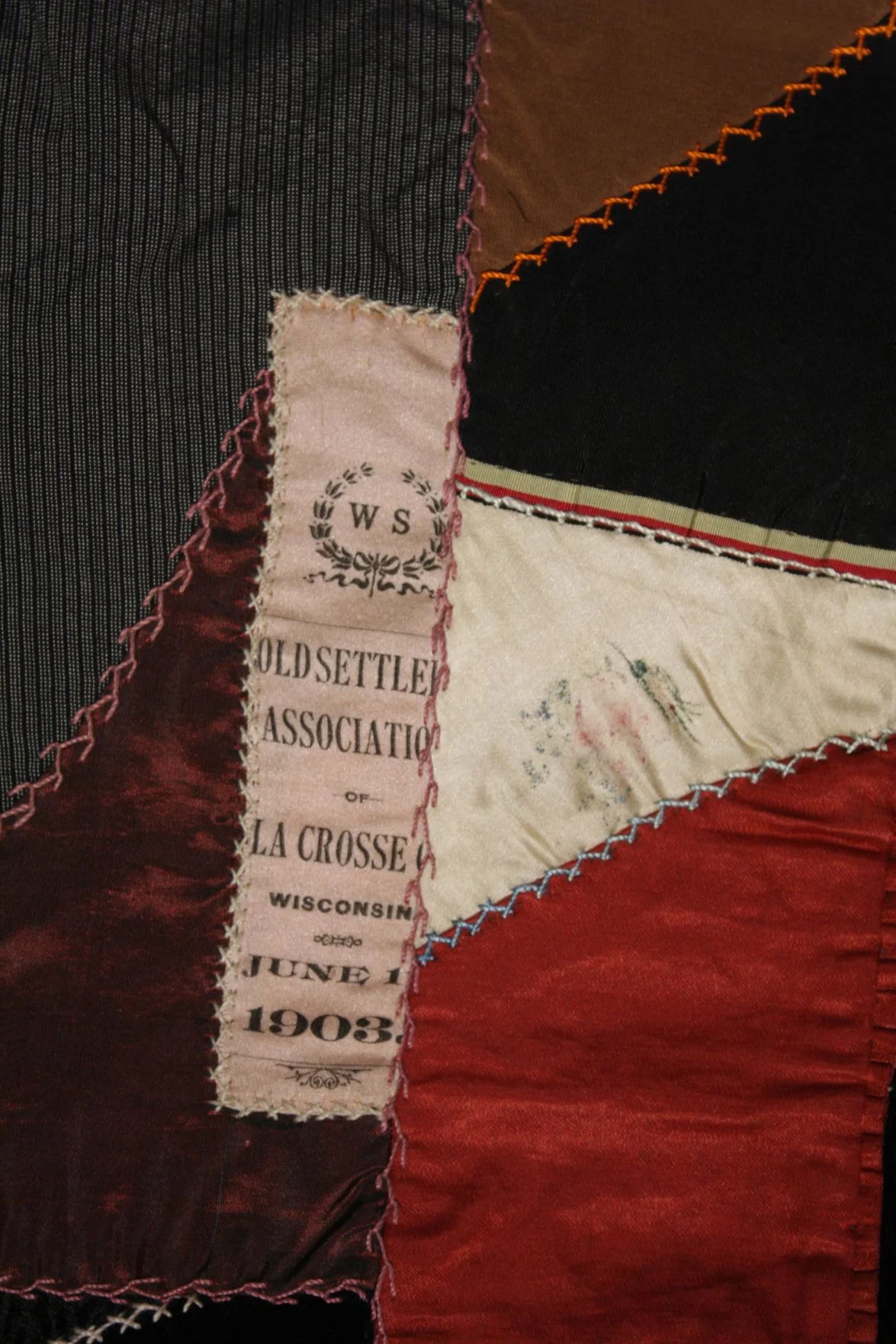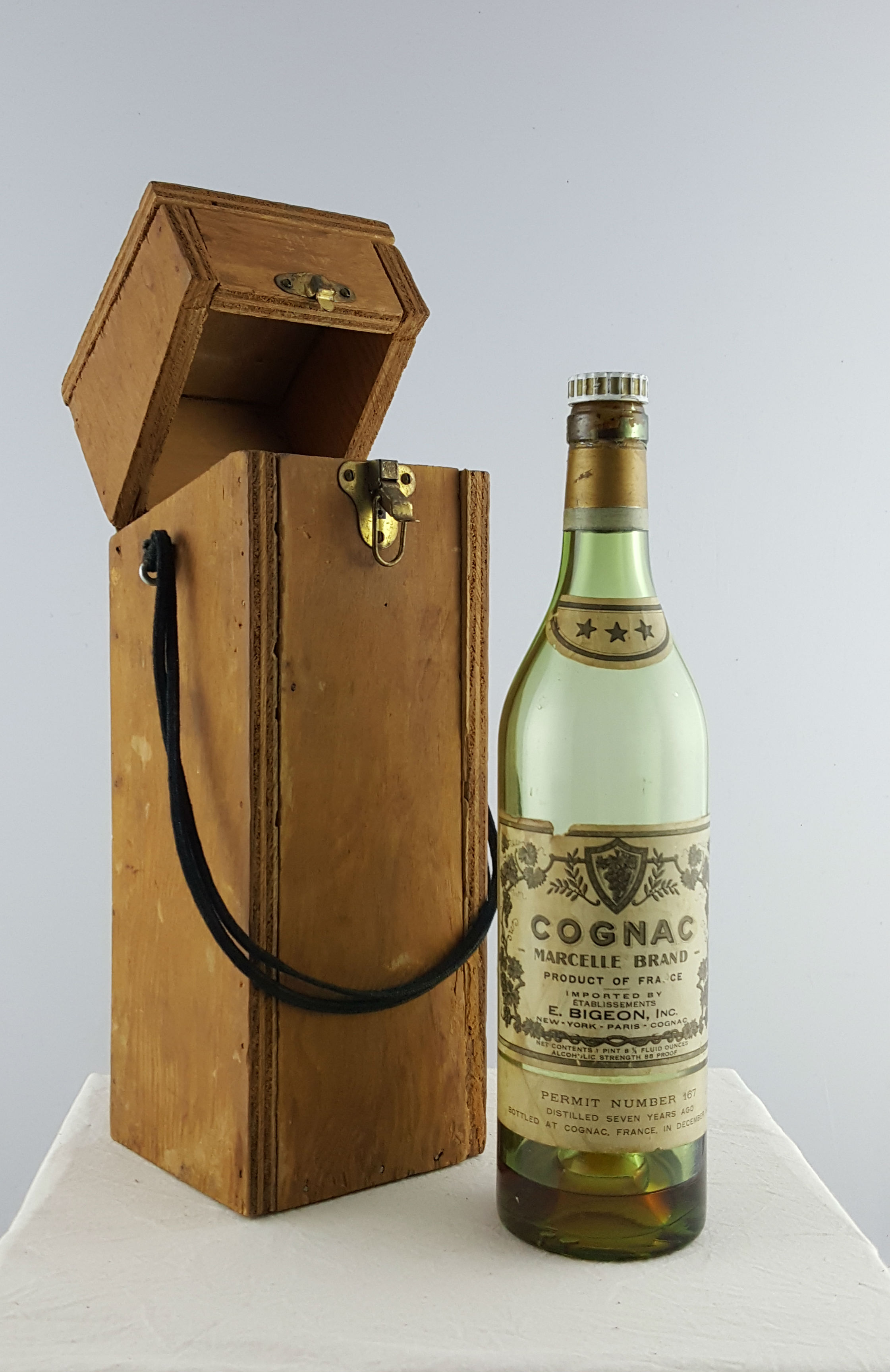Copyright La Crosse County Historical Society
Peggy Derrick
Catalog Number: 1983.007.02
This photo shows a close-up of a crazy quilt made in 1905 by Mary Dalton Jenks Benton. Her family treasured it, and, in 1983, one of them donated it to La Crosse County Historical Society.
It’s hand-pieced in the usual asymmetrical, “crazy” pattern of quilts of this genre. Included among the fabrics are three commemorative ribbons, printed with the names of local La Crosse organizations. This ribbon is a memento of an event held by the Old Settlers Association.
And what was the Old Settlers Association? Why, that was the La Crosse County Historical Society before we adopted the name we have today. And it wasn’t even our first name — that was the La Crosse Pioneer Association, founded in 1870, less than 40 years after Nathan Myrick erected the first permanent European-American cabin on Prairie La Crosse.
Our new name was officially approved in 1898, but as this 1903 ribbon shows, it took a while for the new name to catch on.
We are an old organization. Our mission has grown and evolved as the region has grown. As the names Pioneer and Old Settlers Association suggest, we were first created to honor and preserve the memory of the city’s founders, glorifying men such as Nathan Myrick, John Levy and Thomas Stoddard. The young city needed heroes, whose exploits — real or otherwise — became part of the mythology out of which the town’s identity grew.
With the arrival of the 20th century, and a desire by La Crosse residents to find their place in the larger world, the historical society expanded its focus to share with residents as many wonders of the wide world as its citizens cared to donate. The collection swelled with items brought back from far-away travels, many of them reproductions.
By the mid-20th century, starting with the Colonial Revival of the 1930s and going strong through the country’s bicentennial, the organization was collecting items based on their antiquity. Interest in worldwide curiosities gradually was replaced with a veneration for items viewed as harking back to the country’s, and La Crosse’s, early days.
In the past few decades, this focus has been further refined to what we know best: La Crosse and the Coulee Region. But now our mission to preserve and share local history has expanded to include the stories of everyone who has lived here, and to document history as it is being made.
My goal with the “Things That Matter” series in the La Crosse Tribune has been to share the rich cultural assets and stories that make up the layers of life in the Coulee Region. To fully understand historical events, we need to understand the world in which they took place. These artifacts, some of seemingly minor importance, reflect the world in which events are embedded. It’s all one story, made up of lots of little stories.
These stories, big and small, are what we love to share. It’s what the Historical Society exists for. The objects we feature only matter because the people who made or used them matter. History is about people; it’s what we share, whether we like it or not, sort of like family.
I continue to be gratified by how many of you let us know that you appreciate “Things That Matter.” We need the support of everyone who reads and enjoys these articles. We need your help to grow into the history museum that La Crosse deserves.
Something to be proud of. Isn’t that how you feel about the history of your community? We feel that way, too, and we are proud of the work we do to help the citizens of La Crosse County feel that connection.
No place really becomes a community until it is wrapped in human memory: family stories, tribal traditions, civic commemorations. No place is a community until it has awareness of its history. Our connections and commitment to one another are strengthened when we share stories and experiences.
LCHS is committed to preserving and sharing those stories and experiences with you. And I am asking you to commit to helping us in our mission.Many people don’t realize that, despite the word “county” in our name, we are not part of county government. The La Crosse County Historical Society has been a member-governed 501©3 nonprofit organization since 1939. While county supervisors generously donate a small grant to us each year, we depend on memberships and other donations from individuals for most of our operating expenses.
If you enjoy reading “Things That Matter,” I ask you to support us by joining the La Crosse County Historical Society. Membership levels start at $35 and entitle you to free admission to Historic Hixon House and Riverside Museum, as well as a subscription to the only local publication regularly publishing original articles on local history, our newsletter.
Joining is quick and easy, and can be done on our website, www.lchshistory.org or by calling the office at 608-782-1980. A membership makes a great gift for family who live out of town but who would enjoy receiving our newsletter with its local history articles.
So, join now, and help us make this membership drive a success. And when you open your Saturday morning Tribune and see the “Things That Matter” article, you can take pride in knowing that you help support this engaging series.
This article was originally published in the La Crosse Tribune on November 18, 2017.
This object can be viewed in our online collections database by clicking here.



